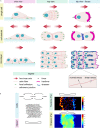Single and collective cell migration: the mechanics of adhesions
- PMID: 28684609
- PMCID: PMC5541834
- DOI: 10.1091/mbc.E17-03-0134
Single and collective cell migration: the mechanics of adhesions
Abstract
Chemical and physical properties of the environment control cell proliferation, differentiation, or apoptosis in the long term. However, to be able to move and migrate through a complex three-dimensional environment, cells must quickly adapt in the short term to the physical properties of their surroundings. Interactions with the extracellular matrix (ECM) occur through focal adhesions or hemidesmosomes via the engagement of integrins with fibrillar ECM proteins. Cells also interact with their neighbors, and this involves various types of intercellular adhesive structures such as tight junctions, cadherin-based adherens junctions, and desmosomes. Mechanobiology studies have shown that cell-ECM and cell-cell adhesions participate in mechanosensing to transduce mechanical cues into biochemical signals and conversely are responsible for the transmission of intracellular forces to the extracellular environment. As they migrate, cells use these adhesive structures to probe their surroundings, adapt their mechanical properties, and exert the appropriate forces required for their movements. The focus of this review is to give an overview of recent developments showing the bidirectional relationship between the physical properties of the environment and the cell mechanical responses during single and collective cell migration.
© 2017 De Pascalis and Etienne-Manneville. This article is distributed by The American Society for Cell Biology under license from the author(s). Two months after publication it is available to the public under an Attribution–Noncommercial–Share Alike 3.0 Unported Creative Commons License (http://creativecommons.org/licenses/by-nc-sa/3.0).
Figures




References
-
- Akhmanova A, Stehbens SJ, Yap AS. Touch, grasp, deliver and control: functional cross-talk between microtubules and cell adhesions. Traffic. 2009;10:268–274. - PubMed
-
- Aragona M, Panciera T, Manfrin A, Giulitti S, Michielin F, Elvassore N, Dupont S, Piccolo S. A mechanical checkpoint controls multicellular growth through YAP/TAZ regulation by actin-processing factors. Cell. 2013;154:1047–1059. - PubMed
MeSH terms
Substances
LinkOut - more resources
Full Text Sources
Other Literature Sources
Research Materials

